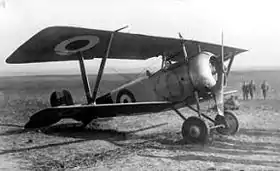D'Arcy Fowlis Hilton
Lieutenant D'Arcy Fowlis Hilton was a Canadian-born American World War I flying ace credited with eight aerial victories.[1]
D'Arcy Fowlis Hilton | |
|---|---|
| Born | 17 October 1889 Toronto, Ontario, Canada |
| Died | October 1973 (aged 83-84) St. Catharines, Ontario, Canada |
| Allegiance | George V of the British Empire |
| Service/ | Aviation |
| Years of service | 1917 - ca. 1918 |
| Rank | Lieutenant |
| Unit | No. 29 Squadron RAF |
| Awards | Military Cross, Air Force Cross |
Early life
D'Arcy Fowlis Hilton was the son of Francis Alfred and Isabel Grace Milligan Hilton.[2] Though born in Canada, he called Michigan home; he also lived in Youngstown, New York.[3]
On 28 January 1914, he married Gladys Caroline Woodruff in St. Thomas, Ontario, Canada.[2][4] They separated in 1916, after a son was born, and he went to England and joined the Royal Flying Corps (RFC) in November. He was commissioned a second lieutenant on 21 November 1916.[2]
World War I service

Hilton earned his Royal Aero Club Certificate No. 4717 on 17 May 1917. He was then assigned to fly a Nieuport 17 with No. 29 Squadron RFC. On 31 July 1917, he destroyed an Albatros D.V fighter and an observation balloon. Over the next three and a half months, he proceeded to drive down out of control five more Albatros D.Vs and an observation plane, with the last victory coming on 13 November 1917.[1] He was gazetted the Military Cross on 17 December 1917.[5][6] Following his tour of combat, Fowler became a flight instructor in both England and Canada, and earned the Air Force Cross in the process.[7]
Post war
Gladys Caroline Woodruff sued him for divorce via act of legislature in 1922.[8] He was then estranged from his family until early in World War II when his son was killed in aerial combat.[1]
D'Arcy Fowlis Hilton died in October 1973 in St. Catharines, Ontario, Canada.[2]
Honors and awards
Military Cross (MC)
2nd/Lt. D'Arcy Fowlis Hilton, R.F.C., Spec. Res.
For conspicuous gallantry and devotion to duty in attacking enemy aircraft and engaging troops on the ground. While on patrol he attacked single-handed six two-seater machines, forcing one down and driving the rest back. He has driven down five other machines.[1][9]
Endnotes
- Over the Front: A Complete Record of the Fighter Aces and Units of the United States and French Air Services, 1914-1918. p. 44.
- The Aerodrome website Retrieved 22 February 2010.
- American Aces of World War 1. p. 42.
- The mesmerizing history of Port Stanley, Archived 15 September 2008 at the Wayback Machine Retrieved 22 February 2010.
- Supplement to the London Gazette, 17 December 1917, p. 13181. Retrieved 22 February 2010.
- Supplement to the London Gazette, 17 December 1917, p. 13182. Retrieved 22 February 2010.
- Nieuport Aces of World War 1. p. 22.
- Journals of the Senate of Canada Retrieved 22 February 2010.
- Supplement to the London Gazette, 23 April 1918, p. 4871. Retrieved 22 February 2010.
References
- Above the Trenches: a Complete Record of the Fighter Aces and Units of the British Empire Air Forces 1915–1920. Shores, Christopher F.; Franks, Norman & Guest, Russell F. Grub Street, 1990. ISBN 978-0-948817-19-9.
- American Aces of World War 1 Harry Dempsey. Osprey Publishing, 2001. ISBN 1-84176-375-6, ISBN 978-1-84176-375-0.
- Nieuport Aces of World War 1. Norman Franks. Osprey Publishing, 2000. ISBN 1-85532-961-1, ISBN 978-1-85532-961-4.
- Over the Front: A Complete Record of the Fighter Aces and Units of the United States and French Air Services, 1914-1918 Norman L. R. Franks, Frank W. Bailey. Grub Street, 1992. ISBN 0-948817-54-2, ISBN 978-0-948817-54-0.